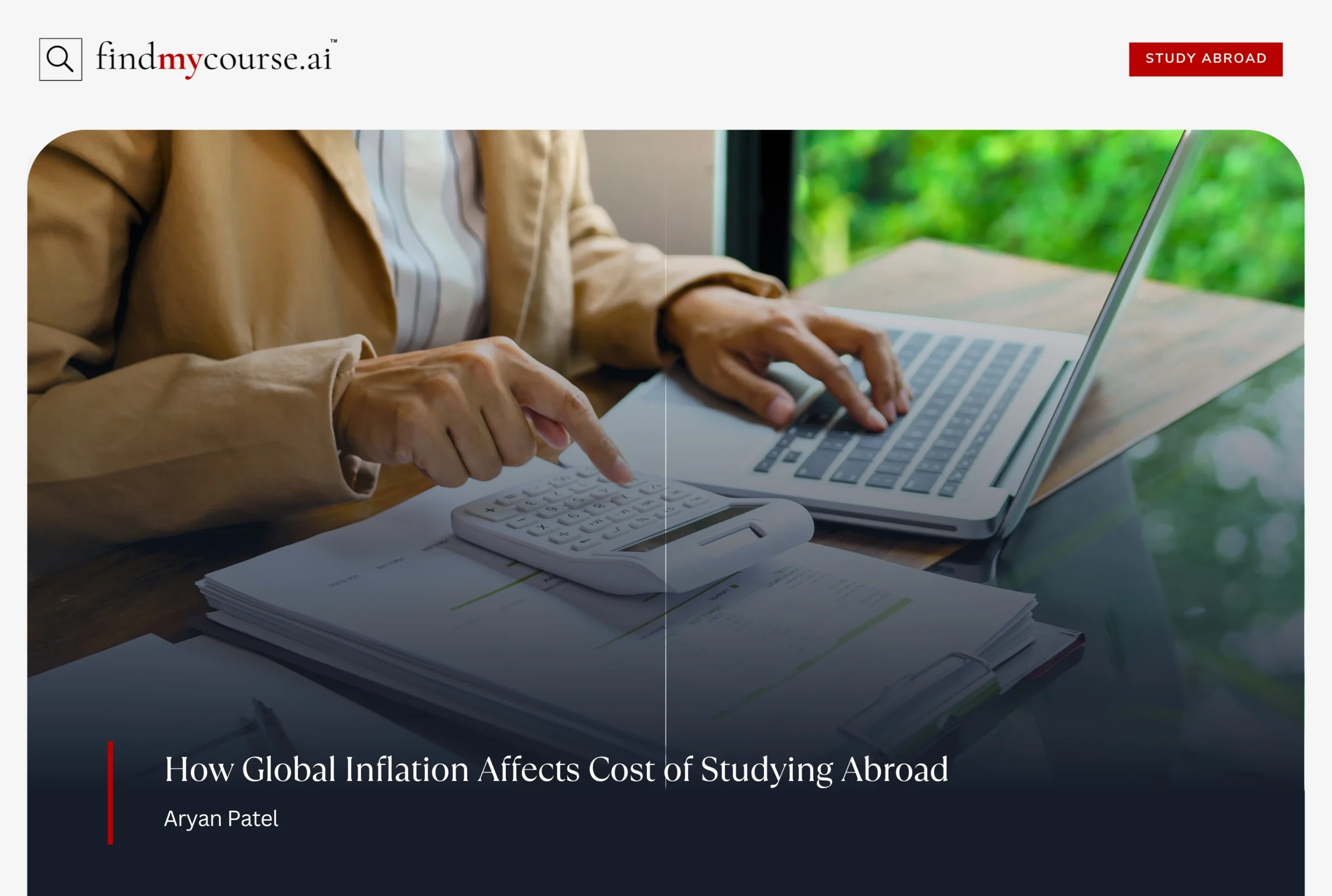For many Indian students, studying abroad is more than an academic choice — it’s a dream of exploring new cultures, gaining global exposure, and building a brighter future. However, this dream comes with a price tag that’s changing faster than ever before. Over the past few years, global inflation has quietly but steadily pushed up the cost of studying abroad. From tuition fees to daily living expenses, almost every part of an overseas education budget has been affected.
In this article, we’ll break down how global inflation is shaping the financial reality of studying overseas, what it means for Indian students and families, and how to plan smartly despite the rising costs.
Understanding Global Inflation and Its Link to Education
Inflation simply means that prices of goods and services go up over time. When this happens globally, it affects almost everything — from food and rent to energy and education.
In recent years, many countries have faced higher inflation due to increased energy prices, supply chain disruptions, and overall economic shifts. As a result, universities, landlords, and service providers in popular student destinations are charging more to cover their rising costs.
For Indian students, this inflation has a double impact:
- Tuition fees abroad are getting higher as universities adjust to their own rising expenses.
- Living costs — such as accommodation, groceries, and transport — have become more expensive.
- Exchange rate changes make studying abroad costlier in Indian rupees, especially when the rupee weakens against the US dollar, pound, or euro.
So even if your course fee stays the same in dollars, you might end up paying much more in rupees by the time you transfer the money.
Rising Tuition Fees and Living Expenses
Tuition Fees
Universities around the world adjust tuition fees every year, and inflation is one of the main reasons. In 2025, the average tuition fee for international students in major destinations like Canada, the UK, and Australia has increased by 4–6%.
For example, an undergraduate degree that cost about USD 38,000 in 2023 may now cost around USD 41,000 or more. The rise may seem small in percentage terms, but when converted into rupees, the difference is significant.
For families planning years in advance, this constant increase makes budgeting challenging. It also means you must plan for a little extra every year, instead of assuming the same amount throughout the course.
Living Expenses
Inflation affects not just tuition but also your day-to-day life abroad. Rent, food, utilities, and public transport have all become more expensive in major student cities.
In the UK, for example, average rent for student accommodation has increased by over 10% in the past two years. In Australia, everyday essentials like groceries and public transport have also seen sharp price hikes.
So even if you manage to find a university with affordable tuition, living costs may still stretch your budget.
How Currency Exchange Rates Affect the Cost of Studying Abroad
For Indian families, the exchange rate is one of the most important — and unpredictable — factors in overseas education planning.
If the Indian rupee weakens against major currencies, your overall cost automatically increases. For instance, if a course costs USD 10,000:
- At ₹70 per dollar, that’s ₹7 lakh.
- At ₹85 per dollar, that becomes ₹8.5 lakh.
That’s a 21% jump in cost without any change in the foreign currency price.
Because of global inflation and economic uncertainty, currencies like the US dollar tend to strengthen, while the rupee faces downward pressure. As a result, the same education abroad becomes more expensive in rupee terms year after year.
Country-Wise Comparison of the Cost of Studying Abroad
To get a clearer picture, let’s compare approximate yearly expenses (tuition + living) for Indian students in 2025 across some popular study destinations:
| Country | Average Annual Cost (Tuition + Living) | Inflation Impact |
| Canada | ₹30–35 lakh | Moderate tuition rise, higher rent and food prices |
| United Kingdom | ₹28–33 lakh | Inflation has pushed up rent and utilities sharply |
| Australia | ₹32–36 lakh | High living costs and tuition increases |
| United States | ₹35–40 lakh | Currency strength and high inflation raise overall cost |
| Germany | ₹15–18 lakh | Public universities remain mostly tuition-free; only living costs up |
| New Zealand | ₹25–30 lakh | Steady tuition rise; inflation mainly in housing |
These figures are averages and vary by city, course, and lifestyle. But overall, it’s clear that studying abroad in 2025 is notably more expensive than it was just a few years ago.
Hidden Costs Students Often Overlook
While most families plan for tuition and accommodation, several smaller costs can quietly add up due to inflation:
- Health insurance: Premiums for international student health plans have increased.
- Utilities and internet: Monthly bills now cost more than before.
- Public transport: Bus and train fares rise almost every year in big cities.
- Study materials: Textbooks, equipment, and lab fees are more expensive.
- Travel: Airfares have also gone up, making trips home costlier.
When you put all these together, the hidden expenses can easily add 10–15% to your total budget.
Why Inflation Affects Indian Students More
Inflation impacts all international students, but Indian students often feel it more because of currency differences and family income levels.
Here’s why:
- Exchange rate disadvantage: Most Indian families earn in rupees, while payments abroad are in stronger currencies. When the rupee falls, the burden increases.
- Limited scholarships: Compared to domestic students, scholarships for Indian students are fewer and more competitive.
- High upfront payments: Visa requirements often demand proof of funds or advance payments, which become harder to manage when inflation increases costs.
- Education loans: Rising costs mean larger loan amounts, leading to higher repayments later.
Therefore, global inflation not only raises expenses but also increases the financial stress on Indian households planning overseas education.
The Broader Effects on Student Choices
Because of these financial pressures, many Indian students are now re-evaluating their study plans.
- Shift to affordable destinations: Countries like Germany, Ireland, and some Nordic nations are gaining popularity due to lower tuition or public funding.
- Preference for shorter programs: One-year master’s programs are becoming more attractive compared to two-year courses.
- Interest in hybrid or online learning: Some students now combine online semesters with shorter in-person study abroad periods to save money.
- Greater focus on return on investment: Students increasingly compare salaries and work opportunities before choosing a course or country.
Overall, inflation is reshaping not just the cost of studying abroad but also how students approach higher education decisions.
Practical Ways to Manage the Rising Cost of Studying Abroad
While inflation is beyond your control, there are several smart ways to manage its impact and keep your study abroad dream alive.
1. Plan and Save Early
Start your financial planning at least two years before applying. This gives your family time to save more, take advantage of better exchange rates, and apply for scholarships without rush.
2. Build a Realistic Budget
Include tuition, living expenses, travel, health insurance, visa fees, and at least a 10% buffer for inflation. Always assume costs will be slightly higher by the time you actually start.
3. Compare Destinations Wisely
If your heart is set on a particular field, explore where you can study it more affordably. For instance, engineering or data science may cost less in Germany or Ireland than in the US.
4. Apply for Scholarships and Grants
Spend time finding scholarships offered by universities, governments, and private foundations. Even partial funding can reduce the burden significantly.
5. Monitor Currency Rates
Keep an eye on exchange rates and plan payments accordingly. If possible, pay tuition when the rupee is relatively strong. Some banks also offer foreign exchange rate protection plans.
6. Consider Part-Time Work
Many countries allow students to work part-time during studies. These earnings can help cover living costs and cushion inflation effects.
7. Track Your Expenses
Once abroad, maintain a monthly budget. Cooking at home, using public transport, and sharing accommodation can make a big difference over time.
8. Evaluate Return on Investment (ROI)
Before choosing a program, check job prospects and average salaries after graduation. It’s important that your future income justifies your total cost of studying abroad.
Long-Term Outlook: What to Expect in the Coming Years
Experts predict that global inflation will remain moderate but not vanish soon. Energy prices, housing shortages, and wage growth in developed countries will likely keep costs high for the next few years.
That means the cost of studying abroad may not drop dramatically anytime soon. However, universities are becoming aware of these challenges and are trying to attract international students through more scholarships, flexible payment plans, and remote learning options.
For Indian students, this means the dream of overseas education remains possible — but it requires more careful planning, awareness, and adaptability than before.
Quick Checklist Before You Go Abroad
Before finalizing your study abroad plans, ask yourself:
- Have I included all possible expenses — tuition, rent, food, insurance, travel?
- Do I have at least 10–15% extra saved as a safety buffer?
- How might the rupee’s exchange rate affect my payments?
- Have I applied for every scholarship or loan option available?
- Does my chosen course provide strong job prospects after graduation?
If you can answer “yes” to all of these, you’re already ahead of most students financially.
Conclusion
The cost of studying abroad has undoubtedly increased because of global inflation, higher living costs, and currency fluctuations. For Indian students, these challenges can seem overwhelming. But with the right preparation, it’s entirely possible to make your dream a reality without unnecessary stress.
The key is to plan early, stay informed, and be flexible. Choose destinations and courses that offer true value for your investment. Keep track of your expenses and take advantage of every opportunity — scholarships, part-time work, and smart budgeting tools.
Remember, education abroad is not just a cost — it’s an investment in your future. And when planned wisely, it can still deliver priceless rewards in global exposure, career growth, and lifelong learning.
FAQs
1. How is global inflation affecting tuition fees?
Universities face rising costs and often pass them on through higher tuition fees. Most international programs have increased prices by 4–6% in 2025.
2. Why has the cost of studying abroad risen more for Indian students?
Because payments are in stronger foreign currencies, and the rupee has weakened, the total cost in rupees has grown sharply.
3. Can choosing a different country reduce costs?
Yes. Countries like Germany, Ireland, or France offer quality education at lower tuition rates, making them attractive alternatives.
4. How can students manage these rising expenses?
Plan early, apply for scholarships, monitor exchange rates, and maintain a strict monthly budget once abroad.
5. Will costs continue to rise in the future?
Experts expect moderate inflation to continue for the next few years, so it’s wise to plan for steady increases rather than sudden relief.


